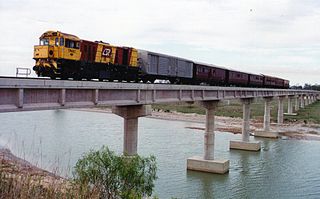The Mirning, also known as the Ngandatha, are an Indigenous Australian people whose traditional lands lay on the coastal region of the Great Australian Bight extending from Western Australia into south-west South Australia.

The Barapa Barapa people are an indigenous Australian people whose territory covered parts of southern New South Wales and northern Victoria. They had close connections with the Wemba-Wemba.
The Dhudhuroa people were an Indigenous Australian people of North-eastern Victoria, in the state of Victoria, Australia.
The Brabiralung were an Indigenous Australian people, one of the five tribes of Gippsland, in the state of Victoria, Australia, and belonged to a wider regional grouping known as the Kurnai.
The Jupagalk were an indigenous Australian people of the State of Victoria. They may have been a Wergaia clan.
The Jaitmatang, also spelled Yaithmathang, were an indigenous Australian people of the State of Victoria.
The Ngaatjatjarra are an Indigenous Australian people of Western Australia.
The Thangkaali (Danggali) are an indigenous Australian people of the state of South Australia.
The Punthamara were an indigenous Australian people of the state of Queensland.
The Maikulan were an indigenous Australian people of the state of Queensland. They have sometimes been confused with the Maithakari.
The Maikathari (Mayi-Thakurti) were an indigenous Australian people of the state of Queensland.
The Maijabi (Mayi-Yapi) were an indigenous Australian people of the state of Queensland.
The Mian were an indigenous people of the state of Queensland.
The Kunandaburi or Karendala (Garandala) were an indigenous Australian people of the state of Queensland.
The Kunggara, also known as Kuritjara, are an indigenous Australian people of the southern Cape York Peninsula in Queensland.
The Yungkurara were an indigenous Australian people of the state of Queensland.
The Kaiabara were an indigenous Australian people of the state of Queensland. Rasther than an independent tribe, they may have been a horde of the Gubbi Gubbi.
The Wanjiwalku were an indigenous Australian people of the state of New South Wales.
The Dhirari or Tirari were an indigenous Australian people of the state of South Australia. They are not to be confused with the Diyari, though the Dirari language is a dialect of Diyari.
The Karangura were an indigenous Australian people of South Australia.







